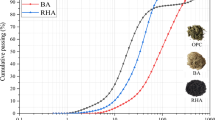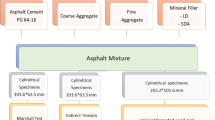Abstract
The utilization of ceramic waste powder (CWP) is increasing in construction industry and influences significantly fresh and mechanical properties of concrete. However, these properties of concrete significantly changed if subjected to higher temperature. Thus, this paper presents the effect of partial replacement of cement to CWP with different weight percent (0%, 20%, 40% and 60%) on the workability, dry density and compressive strength of the concrete. In addition, the influence of elevated temperature (200–800 °C) at 2 h was also carried to investigate the effect on residual compressive strength of the concrete. Furthermore, ANOVA analysis was used for the prediction and optimization of the influenced variables on the compressive strength (response) of the concrete mixes. The results showed that the CWP and temperature significantly influenced the workability, dry density and compressive strength of the concrete mixes. And increasing the percentages of CWP leads to a reduction in the workability, dry density and compressive strength of the concrete mixes. The highest values of workability, dry density and compressive strength were obtained as 240 mm and 220 mm, 2200 kg/\({\mathrm{m}}^{3}\) and 2215 kg/\({\mathrm{m}}^{3}\) and 30 MPa and 33 MPa for A-20 and B-20 mixes, respectively, whereas increasing the temperature caused to decrease the compressive strength of the concrete, and in this context, the maximum residual compressive strength was observed as 32 MPa and 36 MPa for A-20 and B-20, respectively, at 200 °C. Furthermore, CW-A and temperature significantly impact the compressive strength of the concrete, whereas CW-B not. For the optimization, 22% of CW-A, 31.5% of CW-B and 122 °C provide the optimum compressive strength of the concrete. These results give a good indication that CWP could be used in the production of eco-friendly concrete with improved mechanical properties.










Similar content being viewed by others
Change history
17 July 2021
A Correction to this paper has been published: https://doi.org/10.1007/s41062-020-00443-3
References
Law DW, Thomas AAA, Molyneaux K, Wardhono IPA (2015) Long term durability properties of class F fly ash geopolymer concrete. Mater Struct 48:721–731
Singh N, Vyas S, Pathak RP, Sharma P, Mahure NV, Gupta SL (2013) Effect of aggressive chemical environment on durability of green geopolymer concrete. Int J Eng Innov Technol (IJEIT) 3(4):277–284
Abdul Shukor N, Hosseini H, Tahir M, Samadi M, Sam A (2018) Microstructure and strength properties of mortar containing waste ceramic nanoparticles. Arab J Sci Eng 43(10):5305–5313
Gupta T, Chaudhary S, Sharma RK (2014) Assessment of mechanical and durability properties of concrete containing waste rubber tire as fine aggregate. Construct build Mater 30:562–574
Khyaliya RK, Kabeer KS, Vyas AK (2017) Evaluation of strength and durability of lean mortar mixes containing marble waste. Construct Build Mater 147:598–607
Kumar P, Patnaik A, Chaudhary SA (2017) Review on application of structural adhesives in concrete and steel–concrete composite and factors influencing the performance of composite connections. Int J Adhes Adhes 1(77):1–4
Xiao J, Sun W, Li Z, Lange DA, Shah SP (2013) Properties of interfacial transition zones in recycled aggregate concrete tested by Nano indentation. Cement Concrete Compos 37:276–292
Yu X, Tao Z, Song TY, Pan Z (2016) Performance of concrete made with steel slag and waste glass. Construct Build Mater 114:737–746
Zhao H, Poon CS (2017) A comparative study on the properties of the mortar with the cathode ray tube funnel glass sand at different treatment methods. Construct Build Mater 148:900–909
Mashitah MD, Kin CC, Badorul AH (2008) Recycling of homogenous ceramic tiles for the production of concrete block. In: International symposium on environmental management: hazardous-environmental management toward sustainability pp 22–23
Halicka A, Ogrodnik P, Zegardlo B (2013) Using ceramic sanitary ware waste as concrete aggregate. Constr Build Mater 1(48):295–305
Correia JR, De Brito J, Pereira AS (2006) Effects on concrete durability of using recycled ceramic aggregates. Mater Struct 39(2):169–177
Al Bakri AM, Norazian MN, Kamarudin H, Mohd Salleh MA, Alida A (2013) Strength of concrete based cement using recycle ceramic waste as aggregate. In: Advanced Materials Research 2013 (Vol 740, pp 734–738), Trans Tech Publications, Freienbach
Seitl S, Viszlay V, Domski J, Katzer J (2017) Fracture mechanical properties of cement based composites with various amount of waste aggregates. Proc Eng 190:345–351
Medina C, de Rojas MI, Frías M (2013) Freeze-thaw durability of recycled concrete containing ceramic aggregate. J Clean Prod 40:151–160
Alves AV, Vieira TF, De Brito J, Correia JR (2014) Mechanical properties of structural concrete with fine recycled ceramic aggregates. Construct Build Mater 64:103–113
Vieira T, Alves A, de Brito J, Correia JR, Silva RV (2016) Durability-related performance of concrete containing fine recycled aggregates from crushed bricks and sanitary ware. Mater Des 90:767–776
Farinha C, de Brito J, Veiga R (2015) Incorporation of fine sanitary ware aggregates in coating mortars. Construct Build Mater 83:194–206
Awoyera PO, Ndambuki JM, Akinmusuru JO, Omole DO (2018) Characterization of ceramic waste aggregate concrete. HBRC J 14(3):282–287
Siddique S, Chaudhary S, Shrivastava S, Gupta T (2019) Sustainable utilization of ceramic waste in concrete: exposure to adverse conditions. J Clean Prod 10(210):246–255
El Gamal SMA, Hosiny FI, Amin MS, Sayed DG (2017) Ceramic waste as an efficient material for enhancing the fire resistance and mechanical properties of hardened Portland cement pastes. Construct Build Mater 154:1062–1078
Abdullah MM, Hussin K, Ghazali CM, Jamaludin SB (2006) Concrete ceramic waste slab (CCWS). J Eng 3:139–145
Binici H (2007) Effect of crushed ceramic and basaltic pumice as fine aggregates on concrete mortars properties. Construct Build Mater 21(6):1191–1197
Kannan DM, Aboubakr SH, El-Dieb AS, Taha MM (2017) High performance concrete incorporating ceramic waste powder as large partial replacement of Portland cement. Construct Build Mater 144:35–41
Medina C, Frías M, De Rojas MS (2012) Microstructure and properties of recycled concretes using ceramic sanitary ware industry waste as coarse aggregate. Construct Build Mater 31:112–118
AlArab A, Hamad B, Chehab GH, Assaad JJ (2020) Use of ceramic-waste powder as value-added pozzolanic material with improved thermal properties. J Mater Civ Eng 32(9):04020243
Canbaz M (2016) The effect of high temperature on concrete with waste ceramic aggregate. Iran J Sci Technol Trans Civ Eng 40(1):41–48. https://doi.org/10.1007/s40996-016-0002-7
Awoyera P, Wisdom A, Chukwudi O, Ekedum K, Adediran A, Mebitaghan C (2018) Curing, thermal resistance and bending behaviour of laterised concrete containing ceramic wastes. Cogent Eng. https://doi.org/10.1080/23311916.2018.1485476
Mohammadhosseini H, Lim NHAS, Tahir MM, Alyousef R, Mostafa Samadi M, Alabduljabbar H, Mohamed AM (2019) Effects of Waste ceramic as cement and fine aggregate on durability performance of sustainable mortar. Arab J Sci Eng 45:3623–3634. https://doi.org/10.1007/s13369-019-04198-7
Mohammad Hosseini H, Yatim JM (2017) Microstructure and residual properties of green concrete composites incorporating waste carpet fibers and palm oil fuel ash at elevated temperatures. J Clean Prod 144:8–21
Mohammadhosseini H, Lim NHAS, Sam ARM, Samadi M (2018) Effects of Elevated Temperatures on Residual Properties of Concrete Reinforced with Waste Polypropylene Carpet Fibres. Arab J Sci Engi 43:1673–1686. https://doi.org/10.1007/s13369-017-2681-1
Mohammadhosseini H, Tahir MM, Alyousef R, Alabduljabbar H, Mostafa Samadi M (2019) Effect of elevated temperatures on properties of sustainable concrete composites incorporating waste metalized plastic fibres. SN Appl Sci 1:1520. https://doi.org/10.1007/s42452-019-1587-9
Samadi M, Huseien GF, Mohammadhosseini H, Lee HS, Lim NHAS, Mahmood Tahir MM, Alyousef R (2020) Waste ceramic as low cost and eco-friendly materials in the production of sustainable mortars. J Clean Prod 266:121825
Bezerra UT, Martinelli AE, Melo DMA, Melo MAF, Lima FM (2011) A correlation between Bogue’s equations and Taylor’s procedure for the evaluation of crystalline phases in special class Portland oil-well cement clinker. Cerâmica 57(341):122–128. https://doi.org/10.1590/S0366-69132011000100016
ASTM C311 (2016) Standard test methods for sampling and testing fly ash or natural pozzolans for use in Portland-cement concrete, ASTM International, West Conshohocken, PA
ASTM, ASTM C 109 (2010), Standard test method for compressive strength of hydraulic cement mortars, American Society for Testing and Materials
ASTM, ASTM C 511-03 (2003) Standard specification for moist cabinets, moist room, and water storage tanks used in the testing of hydraulic cements and concrete
ASTM C 642 (2006) Density, absorption, and voids in hardened concrete. American society for testing and materials
ASTM C109/C109M-07 (2008) Standard test method for compressive strength of concrete cube specimens. Annual book of ASTM standard, West Conshohocken, PA, Vol 04-01”
ASTM C597-09 (2009) Standard Test Method for Pulse Velocity Through Concrete. American Concrete Institute
Ikponmwosa EE, Ehikhuenmen SO (2017) The effect of ceramic waste as coarse aggregate on strength properties of concrete. Niger J Technol 36(3):691–696
Zhang B, Poon CS (2015) Use of furnace bottom ash for producing lightweight aggregate concrete with thermal insulation properties. J Clean Prod 99:94–100
Oktay H, Yumrutas R, Akpolat A (2015) Mechanical and thermophysical properties of lightweight aggregate concrete. Constr Build Mater 96:217–225
Lo TY, Cui HZ, Tang WC, Leung WM (2008) The effect of aggregate absorption on pore area at interfacial zone of lightweight concrete. Constr Build Master 22:623–628
Piyaphanuwat R, Suwimol Asavapisit S (2017) Utilization ceramic wastes from porcelain ceramic industry in lightweight aggregate concrete. Int J Environ Sci Dev 8(5):342–346
Hamad AJ, Sldozian RJA, Mikhaleva ZA (2020) Effect of ceramic waste powder as partial fine aggregate replacement on properties of fiber-reinforced aerated concrete. Eng Rep 2(3):1–16
Aly ST, El-Dieb AS, Taha MR (2019) Effect of high-volume ceramic waste powder as partial cement replacement on fresh and compressive strength of self-compacting concrete. J Mater Civ Eng 31(2):04018374
Le HT, Ludwig HM (2016) Effect of rice husk ash and other mineral admixtures on properties of self-compacting high performance concrete. Mater Des 89:156–166
Aswin S, Mohanalakshmi V, Alex RA (2018) Effects of ceramic tile powder on properties of concrete and paver block. Glob Res Dev J Eng 3(4):84–87
Ramadevi K (2017) A study on properties of concrete with ceramic waste replaced for fine aggregate. Int J Civ Eng Technol 8(8):1730–1737
Noumowe A (2005) Mechanical properties and microstructure of high strength concrete containing polypropylene fibres exposed to temperatures up to 200°C. Cement Concrete Res 35(11):2192–2198
Hilal NN, Mohammed AS, Ali TKM (2020) Properties of eco-friendly concrete contained limestone and ceramic tiles waste exposed to high temperature. Arab J Sci Eng 45:4387–4404. https://doi.org/10.1007/s13369-020-04482-x
Arioz O (2007) Effects of elevated temperatures on properties of concrete. Fire Saf J 42(8):516–522
Bingöl AF, Gül R (2009) Effect of elevated temperatures and cooling regimes on normal strength concrete. Fire Mater Int J 33(2):79–88
Hertz KD (2005) Concrete strength for fire safety design. Mag Concrete Res 57(8):445–453
Zega CJ, Di Maio AA (2006) Recycled concrete exposed to high temperatures. Mag Concrete Res 58(10):675–682
Banyhussan QS, Qasim GJ, Al-Dahawi AM, Jabar YH (2020) Prediction of fracture parameters for asphalt mixtures using semi-circular bending test. IOP Mater Sci Eng 745:012131
Author information
Authors and Affiliations
Corresponding author
Ethics declarations
Conflict of interest
The authors declare that they have no conflict of interest.
Additional information
The original version of this article was revised due to an correction in the the second point of the conclusion on page no.11
Rights and permissions
About this article
Cite this article
Hilal, N., Saleh, R.D., Yakoob, N.B. et al. Utilization of ceramic waste powder in cement mortar exposed to elevated temperature. Innov. Infrastruct. Solut. 6, 35 (2021). https://doi.org/10.1007/s41062-020-00403-x
Received:
Accepted:
Published:
DOI: https://doi.org/10.1007/s41062-020-00403-x




